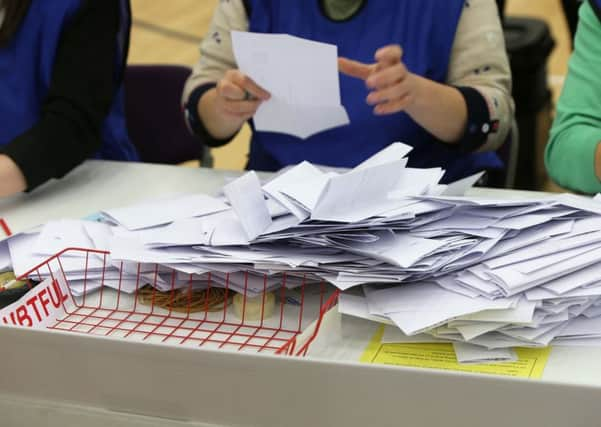PR-STV is a good vote system but its count rules need examined


It is still, however, imperfect, both north and south of the border.
As a northern example, take the Upper Bann constituency in the Assembly elections of 2007.
Advertisement
Hide AdAdvertisement
Hide AdNow like their SF counterparts, many DUP supporters tend to vote DUP 1-2-3, without adding any further preferences.


Well, having just received a transfer of 2,818 votes from an eliminated party colleague, the DUP’s Stephen Moutray was elected at the 12th stage.
With another party colleague already elected and only two candidates contesting the last unfilled seat, one each SF and UUP, it might have been expected that hundreds of his surplus votes would be non-transferable.
Well, no. His surplus was 1,423; 1,413 went to the UUP, 8 to SF, (and 2 votes, recorded as non-transferables, balanced the figures). This outcome seems unbelievable but is explicable due to the ambiguity of the counting rules (see below).
Advertisement
Hide AdAdvertisement
Hide AdThere are similar anomalies down south. There were 2,150,807 votes in the recent election, of which 17,882 were invalid; and that’s all very credible. But of 35,490 votes in 2nd stage surpluses, and a further 1,229 in 3rd stage transfers, (Irish Times, 29th February), not one vote was non-transferable.


This is difficult to believe. Take just three instances.
In Laois, supposedly, all of Fleming’s 3,908 voters cast a 2nd preference; likewise, all of O’Dea’s 3,646 voters in Limerick City; thirdly, in Kerry, all of Michael Healy-Rae’s 7,165 did the same, and in like manner, all 3,835 of these, transfers to his brother, also gave a 3rd preference.
So none of these thousands cast only a single 1st preference? And none of a these hundreds cast only two preferences? This beggars belief.
Something similar may happen at later stages, even after many candidates have been elected/eliminated. A further three examples will suffice: there were no non-transferables at the 5th stage in Kildare South - Heydon, 1,124; at the 9th stage in Donegal - Doherty, 2,382; or even at the last (11th ) stage in Carlow-Kilkenny - Phelan, 2,531. This is as illogical as the above Upper Bann case. Elsewhere, however, more credible results emerged: at the 10th stage In Cavan-Monaghan, Ó Caoláin had 3,137 non-transferrables out of a surplus of 5,251; Creed in Cork North West had 567 out of 3,217; and Munster in Louth, 1,149 out of 1,774.
Advertisement
Hide AdAdvertisement
Hide AdIf a few votes are non-transferable when ‘small’ candidates get eliminated, it doesn’t matter too much, though it might mean that maybe the last candidate is elected by default.
If, however, large numbers of votes are non-transferable when huge surpluses are transferred, then maybe quite a few candidates would end up being elected by default, so the very principle of proportionality would be weakened.
I think it was for this reason that two rules were devised for the one operation, the transfer of surpluses: in some instances, non-transferrables are counted as such; but in others, votes are transferred as if all the votes involved in the surplus had included a subsequent preference. In the latter instance, the transfers are apportioned in the same ratio as those who did express a susbsequent preference.
Which means, of course, that some votes might be transferred without the relevant voters’ knowledge let alone consent.
Advertisement
Hide AdAdvertisement
Hide AdImagine that a candidate was elected with a surplus of 100 votes, of which 40 did not express a subsequent preference and three quarters (45) of the remaining 60 votes transferred to candidate A and the rest (15) to candidate B.
What should happen is that 45 votes go to A, 15 go to B, and 40 are non transferable.
What actually happens sometimes is that 75 votes go to A, 25 votes go to B and none are non transferable.
As you can see, this distorts results.
It seems the election and the count were as always, south and north, conducted with a very professional degree of competence and accuracy.
Advertisement
Hide AdAdvertisement
Hide AdIt is the rules of the count which should be examined, in both jurisdictions, before any further electoral contests.
The NI Minister, George Howarth MP, and an Electoral Officer, Mr. Douglas Bain, both agreed there was a problem, but neither they nor their successors have pursued the matter.
That said, PR-STV is still a very good system.
The obvious (though little known) solution would be the introduction of the Quota Borda System, QBS, in which the voter may cast up to six preferences. The advantages would be several: there would be no transfers of surpluses and eliminations; secondly, every preference cast would be taken into account; and thirdly, while PR-STV only allows for cross-party voting, QBS would actually encourage the voters to cross the party divide.
In a QBS count, success depends either on the candidates’ top preferences (which would be mainly from his/her party supporters) and/or his/her points total, (which could be from across the constituency).
Advertisement
Hide AdAdvertisement
Hide AdAn even better system, the Borda Quota System, BQS, would give initial success to those candidates with the most support overall, ie, get the most points, and only secondary success to those who gained the quota; but BQS hasn’t been invented yet.
• Peter Emerson is director of the de Borda institute, Belfast BT14